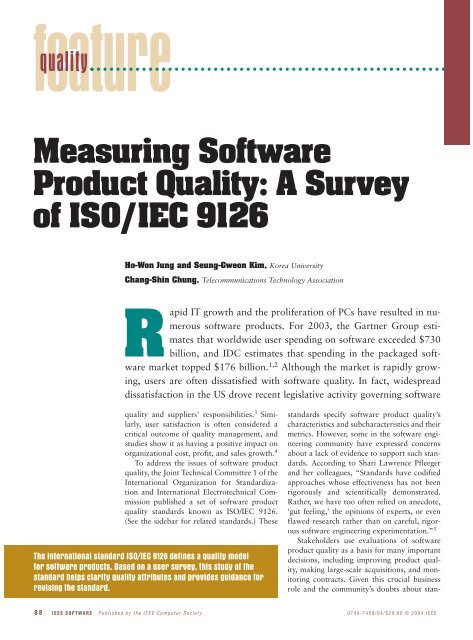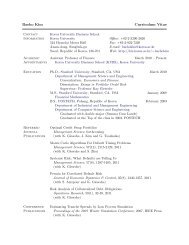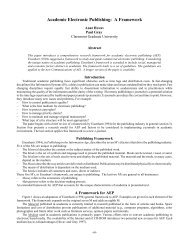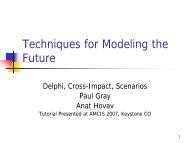Measuring Software Product Quality: A Survey of ISO/IEC 9126 quality
Measuring Software Product Quality: A Survey of ISO/IEC 9126 quality
Measuring Software Product Quality: A Survey of ISO/IEC 9126 quality
You also want an ePaper? Increase the reach of your titles
YUMPU automatically turns print PDFs into web optimized ePapers that Google loves.
standards specify s<strong>of</strong>tware product <strong>quality</strong>’s<br />
characteristics and subcharacteristics and their<br />
metrics. However, some in the s<strong>of</strong>tware engineering<br />
community have expressed concerns<br />
about a lack <strong>of</strong> evidence to support such standards.<br />
According to Shari Lawrence Pfleeger<br />
and her colleagues, “Standards have codified<br />
approaches whose effectiveness has not been<br />
rigorously and scientifically demonstrated.<br />
Rather, we have too <strong>of</strong>ten relied on anecdote,<br />
‘gut feeling,’ the opinions <strong>of</strong> experts, or even<br />
flawed research rather than on careful, rigorous<br />
s<strong>of</strong>tware engineering experimentation.” 5<br />
Stakeholders use evaluations <strong>of</strong> s<strong>of</strong>tware<br />
product <strong>quality</strong> as a basis for many important<br />
decisions, including improving product <strong>quality</strong>,<br />
making large-scale acquisitions, and monitoring<br />
contracts. Given this crucial business<br />
role and the community’s doubts about stanfeature<br />
<strong>quality</strong><br />
<strong>Measuring</strong> <strong>S<strong>of</strong>tware</strong><br />
<strong>Product</strong> <strong>Quality</strong>: A <strong>Survey</strong><br />
<strong>of</strong> <strong>ISO</strong>/<strong>IEC</strong> <strong>9126</strong><br />
Ho-Won Jung and Seung-Gweon Kim, Korea University<br />
Chang-Shin Chung, Telecommunications Technology Association<br />
Rapid IT growth and the proliferation <strong>of</strong> PCs have resulted in numerous<br />
s<strong>of</strong>tware products. For 2003, the Gartner Group estimates<br />
that worldwide user spending on s<strong>of</strong>tware exceeded $730<br />
billion, and IDC estimates that spending in the packaged s<strong>of</strong>tware<br />
market topped $176 billion. 1,2 Although the market is rapidly growing,<br />
users are <strong>of</strong>ten dissatisfied with s<strong>of</strong>tware <strong>quality</strong>. In fact, widespread<br />
dissatisfaction in the US drove recent legislative activity governing s<strong>of</strong>tware<br />
<strong>quality</strong> and suppliers’ responsibilities. 3 Similarly,<br />
user satisfaction is <strong>of</strong>ten considered a<br />
critical outcome <strong>of</strong> <strong>quality</strong> management, and<br />
studies show it as having a positive impact on<br />
organizational cost, pr<strong>of</strong>it, and sales growth. 4<br />
To address the issues <strong>of</strong> s<strong>of</strong>tware product<br />
<strong>quality</strong>, the Joint Technical Committee 1 <strong>of</strong> the<br />
International Organization for Standardization<br />
and International Electrotechnical Commission<br />
published a set <strong>of</strong> s<strong>of</strong>tware product<br />
<strong>quality</strong> standards known as <strong>ISO</strong>/<strong>IEC</strong> <strong>9126</strong>.<br />
(See the sidebar for related standards.) These<br />
The international standard <strong>ISO</strong>/<strong>IEC</strong> <strong>9126</strong> defines a <strong>quality</strong> model<br />
for s<strong>of</strong>tware products. Based on a user survey, this study <strong>of</strong> the<br />
standard helps clarify <strong>quality</strong> attributes and provides guidance for<br />
revising the standard.<br />
88 IEEE SOFTWARE Published by the IEEE Computer Society 0740-7459/04/$20.00 © 2004 IEEE
dards, we found it essential to empirically investigate<br />
whether the <strong>ISO</strong>/<strong>IEC</strong> <strong>9126</strong> categorization<br />
is correct and reliable in evaluating<br />
user satisfaction with the judgment <strong>of</strong> a packaged<br />
s<strong>of</strong>tware product’s <strong>quality</strong>.<br />
<strong>ISO</strong>/<strong>IEC</strong> <strong>9126</strong><br />
<strong>Quality</strong>, according to <strong>ISO</strong> 8402, is “the totality<br />
<strong>of</strong> characteristics <strong>of</strong> an entity that bear<br />
on its ability to satisfy stated and implied<br />
needs.” <strong>ISO</strong>/<strong>IEC</strong> <strong>9126</strong>-1 defines a <strong>quality</strong> model<br />
that comprises six characteristics and 27 subcharacteristics<br />
<strong>of</strong> s<strong>of</strong>tware product <strong>quality</strong> (see<br />
Table 1). Because the <strong>quality</strong> model is generic,<br />
you can apply it to any s<strong>of</strong>tware product by<br />
tailoring to a specific purpose.<br />
<strong>ISO</strong>/<strong>IEC</strong> <strong>9126</strong> also defines one or more<br />
metrics to measure each <strong>of</strong> its subcharacteristics.<br />
For example, the <strong>quality</strong> level <strong>of</strong> a s<strong>of</strong>tware<br />
product’s functionality can be represented by<br />
measured values <strong>of</strong> its five subcharacteristics.<br />
Together, those subcharacteristics include the<br />
properties that the standard posits to constitute<br />
functionality. Following an appropriate<br />
aggregation method, you can combine the five<br />
subcharacteristics’ measured (or survey) values<br />
into a single value on a composite index <strong>of</strong><br />
functionality.<br />
However, if any <strong>of</strong> functionality’s subcharacteristics<br />
measures doesn’t correlate to functionality,<br />
the aggregated value would fail to fully represent<br />
functionality’s <strong>quality</strong> as <strong>ISO</strong>/<strong>IEC</strong> <strong>9126</strong><br />
defines it. In such a case, the unrelated subcharacteristic<br />
should be moved into a more appropriate<br />
characteristic, so that each characteristic<br />
includes homogeneous subcharacteristics. 6<br />
Background and method<br />
Because you can call each <strong>of</strong> <strong>ISO</strong>/<strong>IEC</strong> <strong>9126</strong>’s<br />
six characteristics a dimension, or factor, 7,8 in<br />
statistical terms, the standard’s structure is a<br />
multidimensional concept <strong>of</strong> s<strong>of</strong>tware product<br />
<strong>quality</strong>. (A similar multidimensional concept<br />
would be job satisfaction. For example, you can<br />
be more satisfied or less satisfied with various<br />
combinations <strong>of</strong> your job, supervisor, pay,<br />
and/or workplace.) Our study aims to evaluate<br />
empirically <strong>ISO</strong>/<strong>IEC</strong> <strong>9126</strong>’s dimensionality, or<br />
the classification <strong>of</strong> characteristics, and internal-consistency<br />
reliability. For this purpose, we<br />
conducted a survey in which users evaluated<br />
their satisfaction concerning the <strong>quality</strong> <strong>of</strong> a<br />
packaged s<strong>of</strong>tware product according to the<br />
criteria <strong>of</strong> <strong>ISO</strong>/<strong>IEC</strong> <strong>9126</strong>’s subcharacteristics.<br />
Related Standards<br />
Working Group 6 <strong>of</strong> Subcommittee 7 (<strong>S<strong>of</strong>tware</strong> and Systems Engineering<br />
Standardization) under Joint Technical Committee 1 <strong>of</strong> the International Organization<br />
for Standardization and the International Electrotechnical Commission<br />
is developing standards and technical reports for s<strong>of</strong>tware product<br />
evaluation and metrics. WG 6 has developed <strong>ISO</strong>/<strong>IEC</strong> <strong>9126</strong>-1 (<strong>quality</strong><br />
model), <strong>9126</strong>-2 (external metrics), <strong>9126</strong>-3 (internal metrics), and <strong>9126</strong>-4<br />
(<strong>quality</strong> in use metrics). WG 6 has also developed the <strong>ISO</strong>/<strong>IEC</strong> 14598 series<br />
<strong>of</strong> technical reports, which provide guidance for evaluating s<strong>of</strong>tware<br />
product <strong>quality</strong> on the basis <strong>of</strong> <strong>ISO</strong>/<strong>IEC</strong> <strong>9126</strong>.<br />
JTC1 publishes six types <strong>of</strong> documents. Each type follows all or part <strong>of</strong><br />
the following development stages: preliminary, proposal, preparatory, committee,<br />
approval, and publication. 1 <strong>ISO</strong>/<strong>IEC</strong> <strong>9126</strong>-1 is the international<br />
standard and <strong>9126</strong>-2, -3, and -4 are technical reports.<br />
Reference<br />
1. <strong>ISO</strong>/<strong>IEC</strong> JTC1 Directives, Procedures for the Technical Work <strong>of</strong> <strong>ISO</strong>/<strong>IEC</strong> JTC1, <strong>ISO</strong>/<strong>IEC</strong><br />
JTC1, <strong>ISO</strong>, 1999; www.jtc1.org/directives/toc.htm.<br />
In <strong>ISO</strong>/<strong>IEC</strong> <strong>9126</strong>, “satisfaction” implies “the<br />
capability <strong>of</strong> the s<strong>of</strong>tware product to satisfy<br />
users in a specified context <strong>of</strong> use.” Satisfaction<br />
in that sense refers to the user’s response to interaction<br />
with the product. It includes judgments<br />
about product use rather than about<br />
properties <strong>of</strong> the s<strong>of</strong>tware itself. Of course, in<br />
addition to <strong>ISO</strong>/<strong>IEC</strong> <strong>9126</strong>’s definition, user<br />
satisfaction also can include facets such as the<br />
<strong>quality</strong> <strong>of</strong> service, cost, or developer’s reputation.<br />
However, we limited our survey questions’<br />
wording to cover only the subcharacteristics<br />
as defined by <strong>ISO</strong>/<strong>IEC</strong> <strong>9126</strong>.<br />
Characteristic<br />
Functionality<br />
Reliability<br />
Usability<br />
Efficiency<br />
Maintainability<br />
Portability<br />
Table 1<br />
Characteristics and subcharacteristics<br />
in <strong>ISO</strong>/<strong>IEC</strong> <strong>9126</strong><br />
Subcharacteristics<br />
*Denotes the omitted subcharacteristics in our survey<br />
Suitability, accuracy, interoperability, security, functionality<br />
compliance*<br />
Maturity,* fault tolerance,* recoverability,* reliability compliance*<br />
Understandability, learnability, operability, attractiveness,<br />
usability compliance*<br />
Time behavior, resource utilization, efficiency compliance*<br />
Analyzability, changeability, stability, testability, maintainability<br />
compliance*<br />
Adaptability, installability, replaceability, coexistence, portability<br />
compliance*<br />
September/October 2004 IEEE SOFTWARE 89
Using too few<br />
rating-scale<br />
categories won’t<br />
capture the<br />
questions’ full<br />
discriminatory<br />
powers. Using<br />
too many might<br />
be beyond the<br />
respondents’<br />
discriminatory<br />
powers.<br />
The survey<br />
A marketing department identified 200 users<br />
<strong>of</strong> its company’s packaged s<strong>of</strong>tware product—<br />
a query and reporting tool for business databases.<br />
Of the 200 people we contacted through<br />
email or telephone, 75 (38 percent) responded<br />
to the questionnaire. The respondents included<br />
48 end users, 25 developers who had modified<br />
the tool to embed it in their applications, and<br />
two others—all <strong>of</strong> whom we refer to as users.<br />
We were unable to find any significant differences<br />
in end-user and developer responses.<br />
Rating scale<br />
If you use too few rating-scale categories, the<br />
response won’t capture the questions’ full discriminatory<br />
power. On the other hand, using<br />
too many categories might be beyond the respondents’<br />
limited discriminatory powers. A<br />
Monte Carlo study <strong>of</strong> the number <strong>of</strong> scale<br />
points’ effects on reliability showed that reliability<br />
estimates increased as the number <strong>of</strong> scale<br />
points increased from two to five, but the estimates<br />
decreased as more categories were<br />
added. 9 So, we used a five-category rating scale,<br />
which ranged from very satisfied to very dissatisfied,<br />
and included a “Don’t know” option.<br />
Using this scale, we measured the respondents’<br />
judgments <strong>of</strong> the product’s capability to<br />
satisfy the <strong>ISO</strong>/<strong>IEC</strong> <strong>9126</strong> <strong>quality</strong> subcharacteristics.<br />
For example, one question asked, “How<br />
do you evaluate the capability <strong>of</strong> the s<strong>of</strong>tware<br />
product to provide an appropriate set <strong>of</strong> functions<br />
for specified tasks and user objectives”<br />
We then converted those ratings into numerical<br />
values from 1 (very dissatisfied) to 5 (very<br />
satisfied). This is a common procedure in s<strong>of</strong>tware<br />
engineering and management information<br />
systems.<br />
It’s not uncommon for a survey to have<br />
missing values as well as “Don’t know” replies.<br />
Our study considered “Don’t know” as a missing<br />
value. We used a statistical technique called<br />
imputation to estimate the missing values. 10<br />
Therefore, we could keep all 75 responses in<br />
the data analysis.<br />
Data collection<br />
We performed two pretests <strong>of</strong> the questionnaire<br />
to improve the clarity <strong>of</strong> the questions<br />
concerning the <strong>ISO</strong>/<strong>IEC</strong> <strong>9126</strong> subcharacteristics.<br />
We conducted the first pretest with<br />
10 graduate students majoring in management<br />
information systems. From those results,<br />
we revised the questionnaire and then tested it<br />
using five industry end users again. The second<br />
pretest results led to minor revisions.<br />
Because many pretest respondents had difficulty<br />
relating the <strong>ISO</strong>/<strong>IEC</strong> <strong>9126</strong> reliability<br />
subcharacteristics to their experience with the<br />
product, we removed the reliability questions.<br />
In addition, most respondents had the same<br />
trouble with the compliance subcharacteristics,<br />
defined for each characteristic as “the<br />
s<strong>of</strong>tware product adheres to standards, conventions,<br />
or regulations in laws and similar<br />
prescriptions relating to each characteristic.”<br />
So, we removed the compliance subcharacteristic<br />
for each <strong>of</strong> the remaining five characteristics.<br />
In the end, our questionnaire covered 18<br />
subcharacteristics <strong>of</strong> the five characteristics.<br />
During the survey, we encouraged feedback<br />
from respondents regarding the questionnaire’s<br />
contents.<br />
Dimensionality’s role<br />
Principal component analysis (PCA) is a<br />
statistical method used to investigate an underlying<br />
concept’s dimensionality. 8 Dimensionality<br />
is a concept related to the correlation<br />
between each <strong>of</strong> the measured subcharacteristics<br />
and derived dimensions. A dimension consists<br />
<strong>of</strong> its high-correlated subcharacteristics.<br />
Thus, subcharacteristics within the same dimension<br />
are highly correlated. Correlation coefficients<br />
can range from −1 (a perfect negative<br />
correlation) to 1 (a perfect positive correlation).<br />
The greater the absolute correlation, the<br />
stronger the relationship. Note that subcharacteristics<br />
within the same dimension have the<br />
same sign <strong>of</strong> correlation coefficient.<br />
Investigating dimensionality has two important<br />
aspects. First, before you can use<br />
sums or means <strong>of</strong> measured subcharacteristics’<br />
values, you must ensure that the all <strong>of</strong> the<br />
subcharacteristics that you’re summing are<br />
measuring the same thing. Second, estimating<br />
internal-consistency reliability should use subcharacteristics’<br />
values within the same dimension.<br />
If not, the estimate is deflated.<br />
The correlation coefficients are criteria for<br />
determining the dimensionality classification’s<br />
<strong>quality</strong>. Even though there’s no absolute criterion,<br />
a value <strong>of</strong> more than 0.6 meets a guideline<br />
<strong>of</strong> “mediocre.” 8<br />
Results<br />
Table 2, a simple representation <strong>of</strong> our PCA<br />
90 IEEE SOFTWARE www.computer.org/s<strong>of</strong>tware
Table 2<br />
Correlation coefficients between subcharacteristics and dimensions (>0.6)<br />
Dimension 1 Dimension 2 Dimension 3 Dimension 4 Dimension 5<br />
Analyzability Understandability Time behavior Suitability Security<br />
(0.616) (0.769) (0.805) (0.818) (0.856)<br />
Changeability Learnability Resource utilization Accuracy<br />
(0.653) (0.827) (0.766) (0.648)<br />
Stability Operability Interoperability<br />
(0.814) (0.848) (0.796)<br />
Adaptability Attractiveness<br />
(0.669) (0.616)<br />
Cronbach’s alpha 0.817 0.850 0.758 0.750 –<br />
Percent <strong>of</strong> variance 18.67 17.42 11.90 11.82 7.80<br />
Cumulative percent <strong>of</strong> variance 18.67 36.09 47.99 59.81 67.61<br />
results with the varimax option, shows five dimensions<br />
and their subcharacteristics, with<br />
their correlation coefficients in parentheses.<br />
The table shows only subcharacteristics that<br />
have a correlation coefficient <strong>of</strong> greater than<br />
0.6, along with their dimensions. Thus, <strong>of</strong> the<br />
study’s 18 subcharacteristics, the table shows<br />
only 14. The remaining four subcharacteristics<br />
(testability, installability, replaceability, and coexistence)<br />
did not relate to any dimension.<br />
Summary<br />
We can summarize Table 2’s results as follows:<br />
Dimension 1 comprises four subcharacteristics:<br />
analyzability, changeability, stability,<br />
and adaptability. This subcharacteristics categorization<br />
isn’t consistent with the <strong>ISO</strong>/<strong>IEC</strong><br />
<strong>9126</strong> definition. This result implies that the<br />
four subcharacteristics actually measure the<br />
same intrinsic concept, which is a mixed concept<br />
<strong>of</strong> “maintainability and portability.”<br />
Dimension 2 comprises four subcharacteristics<br />
<strong>of</strong> usability in the <strong>ISO</strong>/<strong>IEC</strong> <strong>9126</strong> definition.<br />
Dimension 3 is compatible with two subcharacteristics<br />
<strong>of</strong> efficiency in the <strong>ISO</strong>/<strong>IEC</strong><br />
<strong>9126</strong> definition.<br />
Dimension 4 comprises three subcharacteristics<br />
<strong>of</strong> functionality; however, the security<br />
subcharacteristic isn’t closely related to the<br />
other functionality subcharacteristics.<br />
Dimension 5 has a single subcharacteristic:<br />
security. A dimension <strong>of</strong> a single subcharacteristic<br />
isn’t recommended because <strong>of</strong> the likely<br />
measurement error. 7 Therefore, if further studies<br />
reach the same classification, security should<br />
be classified as a characteristic rather than a<br />
subcharacteristic, and additional security subcharacteristics<br />
should be defined.<br />
Internal-consistency reliability<br />
Measurement always includes some amount<br />
<strong>of</strong> random error. 7,8 Subcharacteristics are relatively<br />
reliable if random measurement error<br />
minimally affects them. Ambiguities in wording<br />
and inconsistencies in respondents’ interpretations<br />
can affect the measurements’ consistency.<br />
Therefore, to give confidence to our<br />
results, it’s crucial to estimate the amount <strong>of</strong><br />
error.<br />
Cronbach’s alpha coefficient is a popular<br />
method used to estimate the internal-consistency<br />
reliability <strong>of</strong> measurements in s<strong>of</strong>tware engineering.<br />
7,11 Because Cronbach’s alpha is applied<br />
to unidimensional constructs, it’s more<br />
appropriate to compute the internal consistency<br />
for each dimension separately. In the early<br />
stages <strong>of</strong> the research, a Cronbach’s alpha <strong>of</strong><br />
0.7 or higher is considered sufficient. 11 Table 2<br />
shows that Cronbach’s alpha for each dimension<br />
is greater than the recommended value.<br />
The percentages <strong>of</strong> variance in Table 2’s<br />
second-to-last row are summary measures indicating<br />
how much <strong>of</strong> the total original variance<br />
<strong>of</strong> all subcharacteristics each dimension<br />
represents. The first dimension explains 18.67<br />
percent <strong>of</strong> total variance <strong>of</strong> the 18 subcharacteristics.<br />
As the last row shows, all <strong>of</strong> the five<br />
dimensions explain 67.61 percent (cumulative<br />
percent <strong>of</strong> variance) <strong>of</strong> total variance.<br />
Discussions<br />
Users’ perceptions about product <strong>quality</strong><br />
vary across user types. For example, end users<br />
typically value usability more than developers<br />
do. As we noted previously, however, we<br />
couldn’t find any significant differences in<br />
their responses.<br />
Recall also that we omitted the <strong>ISO</strong>/<strong>IEC</strong><br />
<strong>9126</strong> reliability and compliance subcharacteristics<br />
because <strong>of</strong> the difficulty our pretesters<br />
had in relating those concepts. We believe that<br />
definition <strong>of</strong> reliability in the standard is clear<br />
September/October 2004 IEEE SOFTWARE 91
About the Authors<br />
Ho-Won Jung is a pr<strong>of</strong>essor in the Department <strong>of</strong> Business Administration at Korea University.<br />
He’s also the international SPICE research coordinator for the emerging <strong>ISO</strong>/<strong>IEC</strong> 15504<br />
(Process Assessment) international standard and an authorized instructor for introductory<br />
courses in the SEI Capability Maturity Model Integration approach. He received his PhD in management<br />
information systems from the University <strong>of</strong> Arizona. He’s a charter research member<br />
<strong>of</strong> the International Process Research Consortium and is on the <strong>S<strong>of</strong>tware</strong> <strong>Quality</strong> Journal editorial<br />
board. Contact him at the Dept. <strong>of</strong> Business Administration, Korea Univ., Anam-dong 5Ka,<br />
Sungbuk-gu, Seoul 136-701, Korea; hwjung@korea.ac.kr.<br />
Seung-Gweon Kim is a PhD candidate in business administration, majoring in management<br />
information systems, at Korea University. He also worked at the Korea IT promotion<br />
agency. His research interests include s<strong>of</strong>tware <strong>quality</strong> management and IT performance analysis.<br />
He’s also the assessor <strong>of</strong> <strong>ISO</strong>/<strong>IEC</strong> 15504 and Capability Maturity Model Integration. Contact<br />
him at the Dept. <strong>of</strong> Business Administration, Korea Univ., Anam-dong 5Ka, Sungbuk-gu, Seoul<br />
136-701, Korea; sunggweon@korea.ac.kr.<br />
Chang-Shin Chung is a principal member <strong>of</strong> the technical staff for the <strong>S<strong>of</strong>tware</strong> <strong>Quality</strong><br />
Evaluation Team at Telecommunications Technology Association, Korea. He received his PhD<br />
in computer engineering from Chungbuk National University. His research interests are s<strong>of</strong>tware<br />
product <strong>quality</strong> testing and evaluation. Contact him at the Telecommunications Technology<br />
Assoc., 267-2 Seohyeon-dong, Bundang-gu, Seongnam City, Kyunggi-do, 463-824, Korea;<br />
cschung@<br />
tta.or.kr.<br />
and that the reliability subcharacteristics<br />
probably do constitute a distinct dimension. In<br />
contrast, including the six compliance subcharacteristics<br />
leads to two possible results.<br />
The first possibility is that the compliance subcharacteristic<br />
for each characteristic belongs<br />
to its characteristic as defined in <strong>ISO</strong>/<strong>IEC</strong><br />
<strong>9126</strong>. The second possibility is that the six<br />
compliance subcharacteristics constitute a separate<br />
dimension.<br />
Our study’s limitations, although characteristic<br />
<strong>of</strong> most empirical studies, should be made<br />
clear in interpreting our results and are worth<br />
explaining here. Our results are from evaluating<br />
a single packaged-s<strong>of</strong>tware product. No<br />
single study can be fully definitive and widely<br />
generalizable. Further empirical work with<br />
larger and broader samples is necessary to help<br />
us better understand the underlying dimensional<br />
structure. Future studies should also examine<br />
other products to see if the dimensions<br />
are consistent across different s<strong>of</strong>tware types.<br />
In addition, we based our study on the reports<br />
<strong>of</strong> those who use or modify a s<strong>of</strong>tware<br />
product. In large s<strong>of</strong>tware acquisitions, s<strong>of</strong>tware<br />
buyers might be different from the users<br />
who participated in this study. Thus, future<br />
work should examine the difference in dimensionality<br />
between buyer and user.<br />
We also based our study on a sample data<br />
collected in Korea. Cultural differences might<br />
exist in recognizing and making judgments<br />
about the <strong>ISO</strong>/<strong>IEC</strong> <strong>9126</strong> <strong>quality</strong> subcharacteristics.<br />
Because the standard is intended for<br />
worldwide use, we hope to see this study replicated<br />
in other countries.<br />
Our results reveal ambiguities in the<br />
way that <strong>ISO</strong>/<strong>IEC</strong> <strong>9126</strong> is structured<br />
in terms <strong>of</strong> characteristics and subcharacteristics.<br />
Although the results also provide<br />
evidence <strong>of</strong> much <strong>of</strong> that structure’s validity,<br />
additional empirical work is necessary<br />
for clarity.<br />
Systematic sample surveys can provide<br />
meaningful and widely generalizable statistical<br />
results at a moderate cost. However, the survey<br />
data should be augmented with more comprehensive<br />
measures <strong>of</strong> product <strong>quality</strong> in future<br />
studies. Replications <strong>of</strong> our study using other<br />
statistical analytic methods such as confirmatory<br />
factor analysis are also necessary to substantiate<br />
or clarify the present results.<br />
References<br />
1. G. Shiffler et al., Gartner Dataquest Market Databook,<br />
March 2003 Update, Gartner, 2003.<br />
2. IDC, Worldwide Black Book, vol. Q2, 2003.<br />
3. C. Kaner, “<strong>S<strong>of</strong>tware</strong> Engineering and UCITA,” The<br />
John Marshall J. Computer and Information Law, vol.<br />
18, no. 2, 2000.<br />
4. C.N. Madu, C.H. Kuei, and R.A. Jacob, “An Empirical<br />
Assessment <strong>of</strong> the Influence <strong>of</strong> <strong>Quality</strong> Dimensions on<br />
Organizational Performance,” Int’l J. <strong>Product</strong>ion Research,<br />
vol. 34, no. 7, 1996, pp. 1943–1962.<br />
5. S.L. Pfleeger, N. Fenton, and S. Page, “Evaluating <strong>S<strong>of</strong>tware</strong><br />
Engineering Standards,” Computer, vol. 27, no. 9,<br />
1994, pp. 71–79.<br />
6. T.L. Saaty, Fundamentals <strong>of</strong> Decision Making and Priority<br />
Theory, RWS, 1994.<br />
7. J.P. McIver and G.E. Carmines, Unidimensional Scaling,<br />
Sage Univ. Paper Series on Quantitative Applications in<br />
Social Sciences, Sage, 1981.<br />
8. S. Sharma, Applied Multivariate Techniques, John Wiley<br />
& Sons, 1996.<br />
9. R.W. Lissitz and S.B. Green, “Effects <strong>of</strong> the Number <strong>of</strong><br />
Scale Points on Reliability: A Monte Carlo Approach,”<br />
J. Applied Psychology, vol. 60, no. 1, 1975, pp. 10–13.<br />
10. A. Carlos and F. Harrell, An Introduction to S and the<br />
Hmisc and Design Libraries, ch. 4, 2004, http://biostat.<br />
mc.vanderbilt.edu/twiki/pub/Main/RS/sintro.pdf.<br />
11. J.C. Nunnally and I.H. Bernstein, Psychometric Theory,<br />
McGraw-Hill, 1994.<br />
For more information on this or any other computing topic, please visit our<br />
Digital Library at www.computer.org/publications/dlib.<br />
92 IEEE SOFTWARE www.computer.org/s<strong>of</strong>tware






